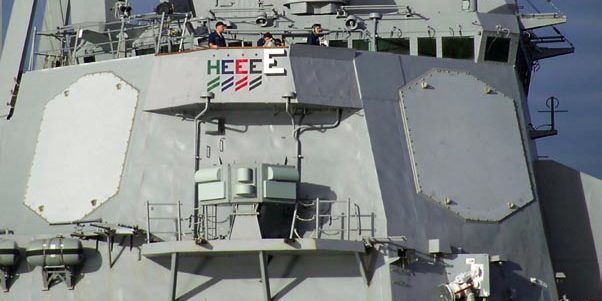For Classic Spinning Radar, why not multiple Dishes in one
https://en.wikipedia.org/wiki/Airport_s ... ance_radar
For Classical Radar that have to rotate in place to provide data coverage like Airport Radars, why are there not options for Back to Back Dishes or 3x Direction Dishes that are angled 120° apart.
Wouldn't having 2-3x the information update speed be valuable, or is the cost not worth the extra expense?
Or is there some other technical consideration that I'm not understanding?
For Classical Radar that have to rotate in place to provide data coverage like Airport Radars, why are there not options for Back to Back Dishes or 3x Direction Dishes that are angled 120° apart.
Wouldn't having 2-3x the information update speed be valuable, or is the cost not worth the extra expense?
Or is there some other technical consideration that I'm not understanding?
- Elite 1K

- Posts: 1557
- Joined: 01 May 2017, 09:07
Radar reflector has sidelobes, which are Non-zero beam distributions separated from the desired direction. Radio astronomy dishes could receive signals from ground even when pointing upward. So 3 dishes 120 deg apart will make things lot worse. One dish will receive returns from the other two.
zhangmdev wrote:Radar reflector has sidelobes, which are Non-zero beam distributions separated from the desired direction. Radio astronomy dishes could receive signals from ground even when pointing upward. So 3 dishes 120 deg apart will make things lot worse. One dish will receive returns from the other two.
Ok, so 3 dishes might be too much.
What about 2 dishes, back to back?
With proper shielding in between the backs of the two dishes, will that protect from any spare Sidelobe signals?
The most classic example of multi-antenna radar is the AEGIS AN/SPY-1 which has 4 antennae each 90 degrees apart. Multiple antennae give you continuous coverage but of course you are then splitting up your TR modules whereas with one that rotates you can build a more powerful one but then there would be momentary delays in updates due to rotation. For slow moving consistent course civil air planes there is no real reason to go for the extra cost and complexity of splitting up your radar antenna but for a military radar which has to account for ballistic missiles and pop-up cruise missiles where speed of reaction is of the essence there is benefit to having multi-antenna radar.
https://missiledefenseadvocacy.org/defe ... y-1-radar/

https://missiledefenseadvocacy.org/defe ... y-1-radar/

- Elite 1K

- Posts: 1557
- Joined: 01 May 2017, 09:07
The OP seems to limit the question to mechanical scanning systems, with rotating reflectors.
Electronic scanning system acts like a lot of tiny fixed dishes, using phase shifter to direct radar beams. There is a limit how far those beams can be directed away from the array facing direction, so either the whole array needs to rotate or there should be multiple arrays facing different directions.
Here is a visualization of the beam pattern of a dish antenna, not of a radar but similar. It is most sensitive alone the main beam, but spread out into multiple side lobes. It even has a back lobe.
https://www.wirmax.net/img/cms/rf_eleme ... ez-new.jpg
Electronic scanning system acts like a lot of tiny fixed dishes, using phase shifter to direct radar beams. There is a limit how far those beams can be directed away from the array facing direction, so either the whole array needs to rotate or there should be multiple arrays facing different directions.
Here is a visualization of the beam pattern of a dish antenna, not of a radar but similar. It is most sensitive alone the main beam, but spread out into multiple side lobes. It even has a back lobe.
https://www.wirmax.net/img/cms/rf_eleme ... ez-new.jpg
I know how modern AESA/PESA works, that's not the issue.
That's why I was curious for classical Radar systems.
I know I've seen 1 or 2 Classical Rotating Radar Systems with Back to Back Radar Dishes somewhere.
But is there any technical reason why you can't at least 1/2 or 1/3 your scanning refresh time for classical spinning radar?
That's why I was curious for classical Radar systems.
I know I've seen 1 or 2 Classical Rotating Radar Systems with Back to Back Radar Dishes somewhere.
But is there any technical reason why you can't at least 1/2 or 1/3 your scanning refresh time for classical spinning radar?
- Elite 1K

- Posts: 1557
- Joined: 01 May 2017, 09:07
Besides the side lobe problem, "refresh time" usually isn't important to applications like weather and air traffic control. Old air defense system has 360 deg rotating air search radar. Once the target is identified, it rotates tracking radar and missile guiding device to face the target. Some scanning radar only covers a narrow field-of-view. So "refresh time" isn't important here either. To have a bigger dish/reflector for better resolution is more important. Also you want to build it simpler, light weight, and cheaper.
Look up BACK TRAP for an example of back to back radar dishes.
That said, most mechanical radars rotate at about 6 rpm so targets are refreshed every 10 seconds. Unless you're an SR-71 that it good enough.
that it good enough.
That said, most mechanical radars rotate at about 6 rpm so targets are refreshed every 10 seconds. Unless you're an SR-71
Roscoe
F-16 Program Manager
USAF Test Pilot School 92A
"It's time to get medieval, I'm goin' in for guns" - Dos Gringos
F-16 Program Manager
USAF Test Pilot School 92A
"It's time to get medieval, I'm goin' in for guns" - Dos Gringos
You mean this beautiful design =DRoscoe wrote:Look up BACK TRAP for an example of back to back radar dishes.
That said, most mechanical radars rotate at about 6 rpm so targets are refreshed every 10 seconds. Unless you're an SR-71that it good enough.
https://www.radartutorial.eu/19.kartei/ ... 41.en.html
12 posts
|Page 1 of 1
Who is online
Users browsing this forum: No registered users and 3 guests


